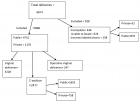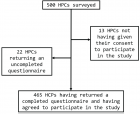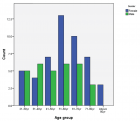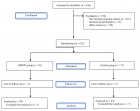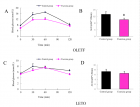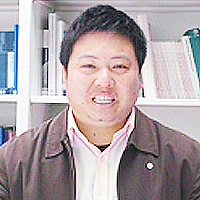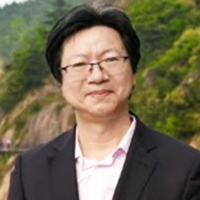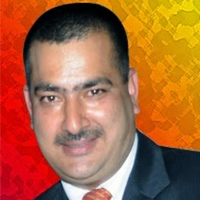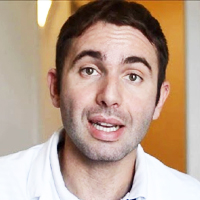Abstract
Case Report
Using Mathematical Procedure to Compute the Attenuation Coefficient in Spectrometry Field
Mohamed. S. Badawi*, Mohamed Elsaf, Mona. M. Gouda, Abouzeid A Thabet, Ahmed M El-Khatib, Mahmuod I Abbas and Kholud. S. Almugren
Published: 06 February, 2017 | Volume 1 - Issue 1 | Pages: 022-030
In gamma-ray spectrometry, the analysis of the environmental radioactivity samples (soil, sediment and ash of a living organism) needs to know the linear attenuation coefficient of the sample matrix. This coefficient is required to calculate the self-absorption correction factor through the sample bulk. In addition, these parameters are very important because the unidentified samples can be different in the composition and density from the reference liquid sources which are usually used for efficiency calibration in the radioactive monitoring process. The present work is essentially concerned to introduce a mathematical method to calculate the linear attenuation coefficient without using any collimator. This method was based mainly on the calculations of the effective solid angle subtended by the source-to-the detector configurations, the efficiency transfer technique and the average path lengths through the samples itself. The method can be used as a tool for the calculation of the linear attenuation coefficient of unidentified materials with good facility to use it in the calibration process of γ-ray detectors, particularly in the study of soil samples. The results are compared with the data from NIST-XCOM to show how much the results are in close agreement and to give the validity of the approach.
Read Full Article HTML DOI: 10.29328/journal.jro.1001003 Cite this Article Read Full Article PDF
Keywords:
Gamma-ray spectrometry; Linear attenuation coefficient; Effective solid angle; Average path length; Mathematical method
References
- Knoll GF. Radiation Detection and Measurement. Third edition. (Wiley, 2000)
- Abbas MI, Selim YS, Bassiouni M. HPGe detector photopeak efficiency calculation including self-absorption and coincidence corrections for cylindrical sources using compact analytical expressions. Radiat Phys and Chem. 2001; 61: 429-431. Ref.: https://goo.gl/uNMCQ6
- Hernandez F, El-Daoushy F. Nucl Instrum Methods. Phys Res. A Accel Spectrom Detect Assoc. Equip. 2002; 484: 625-641.
- Robu E, Giovani C. Rom. Rep Phys. 2009; 61: 395-300.
- Berger MJ, Hubbell JH, Seltzer SM, et al. NIST, PML, Radiation and Biomolecular Physics Division. 2010
- Jalali M, Mohammadi A. Gamma ray attenuation coefficient measurement for neutron-absorbent materials. Radiat Phys and Chem. 2008; 77: 523-527. Ref.: https://goo.gl/UsgM1t
- Midgley SM. Measurements of the X-ray linear attenuation coefficient for low atomic number materials at energies 32-66 and Full-size image (<1 K). Radiat Phys and Chem. 2005; 72: 525-535. Ref.: https://goo.gl/RCN6Ow
- Rettschlag M, Berndt R, Mortreau P. Nucl Instrum Methods Phys Res A: Accel Spectrom Detect Assoc Equip. 2007; 581: 765-771. Ref.: https://goo.gl/h6GDal
- Seven S, Karahan IH, Bakkaloglu OF. The measurement of total mass attenuation coefficients of CoCuNi alloys. J Quant Spectrosc Radiat Transf. 2004; 83: 237-242. Ref.: https://goo.gl/CJtmfS
- Badawi MS. Accurate calculation of well-type detector geometrical efficiency using sources with different shapes and geometries. Journal of Instrumentation. 2015; 10. Ref.: https://goo.gl/q0BuFQ
- Abbas MI. Direct mathematical method for calculating full-energy peak efficiency and coincidence corrections of HPGe detectors for extended sources. Nucl Instrum Meth. 2007; 256: 554-557. Ref.: https://goo.gl/jKwFlE
- Abbas MI. A new analytical method to calibrate cylindrical phoswich and LaBr3(Ce) scintillation detectors. Nucl Instrum Meth. 2010; 621: 413-418. Ref.: https://goo.gl/AxlCuG
- Thabet AA, Dlabac AD, Jovanović SI, Badawi Mohamed S, Mihaljevic Nikola N, et al. Nuclear Technology & Radiation Protection. 2015; 30: 35-46. Ref.: https://goo.gl/VSnZSI
- Badawia MS, Abd-Elzaherb M, Abouzeid A Thabetc, Ahmed M. El-khatib. An empirical formula to calculate the full energy peak efficiency of scintillation detectors. Applied Radiation and Isotopes. 2013; 74: 46-49. Ref.: https://goo.gl/k5DOq6
- Badawi MS, Ruskov I, Gouda MM, El-Khatib AM, Alotiby MF, et al. A numerical approach to calculate the full-energy peak efficiency of HPGe well-type detectors using the effective solid angle ratio. Journal of Instrumentation. 2014; 9: Ref.: https://goo.gl/kuuoYF
- El-Khatib AM, Badawi MS, Thabet AA, Jovanovic SI, Gouda MM, et al. Well-type NaI(Tl) detector efficiency using analytical technique and ANGLE 4 software based on radioactive point sources located out the well cavity. Chinese Journal of Physics. 2016; 54: 338-346. Ref.: https://goo.gl/XVXm3R
- Badawi MS. A numerical simulation method for calculation of linear attenuation coefficients of unidentified sample materials in routine gamma ray spectrometry. Nuclear Technology and Radiation Protection. 2015; 30: 249-259. Ref.: https://goo.gl/BKJ6JL
Figures:
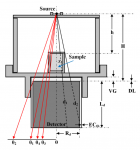
Figure 1

Figure 2
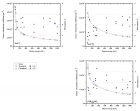
Figure 3
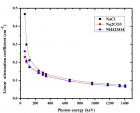
Figure 4
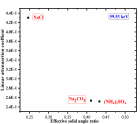
Figure 5
Similar Articles
-
Using Mathematical Procedure to Compute the Attenuation Coefficient in Spectrometry FieldMohamed. S. Badawi*,Mohamed Elsaf,Mona. M. Gouda,Abouzeid A Thabet,Ahmed M El-Khatib,Mahmuod I Abbas,Kholud. S. Almugren. Using Mathematical Procedure to Compute the Attenuation Coefficient in Spectrometry Field. . 2017 doi: 10.29328/journal.jro.1001003; 1: 022-030
-
Empirical formulae for calculating γ-ray detectors effective solid angle ratioMohamed. S. Badawi*,Ahmed M El Khatib,Mohamed A Elzaher,Mona M Gouda,Abouzeid A Thabet,Mahmoud I Abbas,Kholud S Almugren. Empirical formulae for calculating γ-ray detectors effective solid angle ratio. . 2017 doi: 10.29328/journal.jro.1001002; 1: 012-021
-
Investigation of radiation attenuation parameters of some drugs used in Chemotherapy in Wide Energy RegionFerdi Akman*,Mustafa Recep Kaçal. Investigation of radiation attenuation parameters of some drugs used in Chemotherapy in Wide Energy Region. . 2018 doi: 10.29328/journal.jro.1001021; 2: 047-052
Recently Viewed
-
Myeloid Neoplasms: Better Understanding of their Molecular Pathogenesis with Improvised Genomic Testing: A Ray of Hope for Better Clinical OutcomesBhardwaj Tina Neelesh*, Phani MN. Myeloid Neoplasms: Better Understanding of their Molecular Pathogenesis with Improvised Genomic Testing: A Ray of Hope for Better Clinical Outcomes. J Hematol Clin Res. 2024: doi: 10.29328/journal.jhcr.1001027; 8: 001-007
-
Prevalence and Risk Factors to Preterm Labor through a Study in Jiblah University Hospital, Ibb, Governorate, YemenAfaf Alsharif*,Zainab Said,Fatima Mokabes,Leena Ameen,Alya Alqadri,Thekra Musaed,Bushra Musaed,Ala’a Ahmed,Halaa Rigih. Prevalence and Risk Factors to Preterm Labor through a Study in Jiblah University Hospital, Ibb, Governorate, Yemen. J Community Med Health Solut. 2025: doi: 10.29328/journal.jcmhs.1001053; 6: 020-026
-
Evaluation of Biostimulants Based on Recovered Protein Hydrolysates from Animal By-products as Plant Growth EnhancersH Pérez-Aguilar*, M Lacruz-Asaro, F Arán-Ais. Evaluation of Biostimulants Based on Recovered Protein Hydrolysates from Animal By-products as Plant Growth Enhancers. J Plant Sci Phytopathol. 2023: doi: 10.29328/journal.jpsp.1001104; 7: 042-047
-
Endometriosis as a risk factor for colorectal cancerVíctor Manuel Vargas-Hernández*,José María Tovar- Rodríguez,Víctor Manuel Vargas-Aguilar . Endometriosis as a risk factor for colorectal cancer. Clin J Obstet Gynecol. 2020: doi: 10.29328/journal.cjog.1001057; 3: 093-097
-
Adult Neurogenesis: A Review of Current Perspectives and Implications for Neuroscience ResearchAlex, Gideon S*,Olanrewaju Oluwaseun Oke,Joy Wilberforce Ekokojde,Tolulope Judah Gbayisomore,Martina C. Anene-Ogbe,Farounbi Glory,Joshua Ayodele Yusuf. Adult Neurogenesis: A Review of Current Perspectives and Implications for Neuroscience Research. J Neurosci Neurol Disord. 2024: doi: 10.29328/journal.jnnd.1001102; 8: 106-114
Most Viewed
-
Evaluation of Biostimulants Based on Recovered Protein Hydrolysates from Animal By-products as Plant Growth EnhancersH Pérez-Aguilar*, M Lacruz-Asaro, F Arán-Ais. Evaluation of Biostimulants Based on Recovered Protein Hydrolysates from Animal By-products as Plant Growth Enhancers. J Plant Sci Phytopathol. 2023 doi: 10.29328/journal.jpsp.1001104; 7: 042-047
-
Sinonasal Myxoma Extending into the Orbit in a 4-Year Old: A Case PresentationJulian A Purrinos*, Ramzi Younis. Sinonasal Myxoma Extending into the Orbit in a 4-Year Old: A Case Presentation. Arch Case Rep. 2024 doi: 10.29328/journal.acr.1001099; 8: 075-077
-
Feasibility study of magnetic sensing for detecting single-neuron action potentialsDenis Tonini,Kai Wu,Renata Saha,Jian-Ping Wang*. Feasibility study of magnetic sensing for detecting single-neuron action potentials. Ann Biomed Sci Eng. 2022 doi: 10.29328/journal.abse.1001018; 6: 019-029
-
Pediatric Dysgerminoma: Unveiling a Rare Ovarian TumorFaten Limaiem*, Khalil Saffar, Ahmed Halouani. Pediatric Dysgerminoma: Unveiling a Rare Ovarian Tumor. Arch Case Rep. 2024 doi: 10.29328/journal.acr.1001087; 8: 010-013
-
Physical activity can change the physiological and psychological circumstances during COVID-19 pandemic: A narrative reviewKhashayar Maroufi*. Physical activity can change the physiological and psychological circumstances during COVID-19 pandemic: A narrative review. J Sports Med Ther. 2021 doi: 10.29328/journal.jsmt.1001051; 6: 001-007

HSPI: We're glad you're here. Please click "create a new Query" if you are a new visitor to our website and need further information from us.
If you are already a member of our network and need to keep track of any developments regarding a question you have already submitted, click "take me to my Query."






